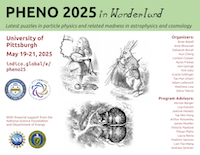Speaker
Description
Recent observations from pulsar timing-array collaborations have provided compelling evidence for the existence of a stochastic gravitational wave background (SGWB). While astrophysical sources such as mergers of supermassive black hole binaries are likely contributors, additional signals may arise from early-universe phenomena or modified gravity theories. These different origins are expected to exhibit distinct anisotropic features: astrophysical sources are anticipated to produce a highly anisotropic SGWB, whereas cosmological sources would result in a more isotropic background with small fluctuations. The goal of the present work is to analyze the anisotropies of the SGWB. More specifically, we aim to provide estimates for anisotropies and perform distinction between intrinsic anisotropies of the background and those induced kinematically by our relative motion, similar to the kinematic dipole observed in the Cosmic Microwave Background (CMB). This analysis could provide an independent test of the CMB dipole.

